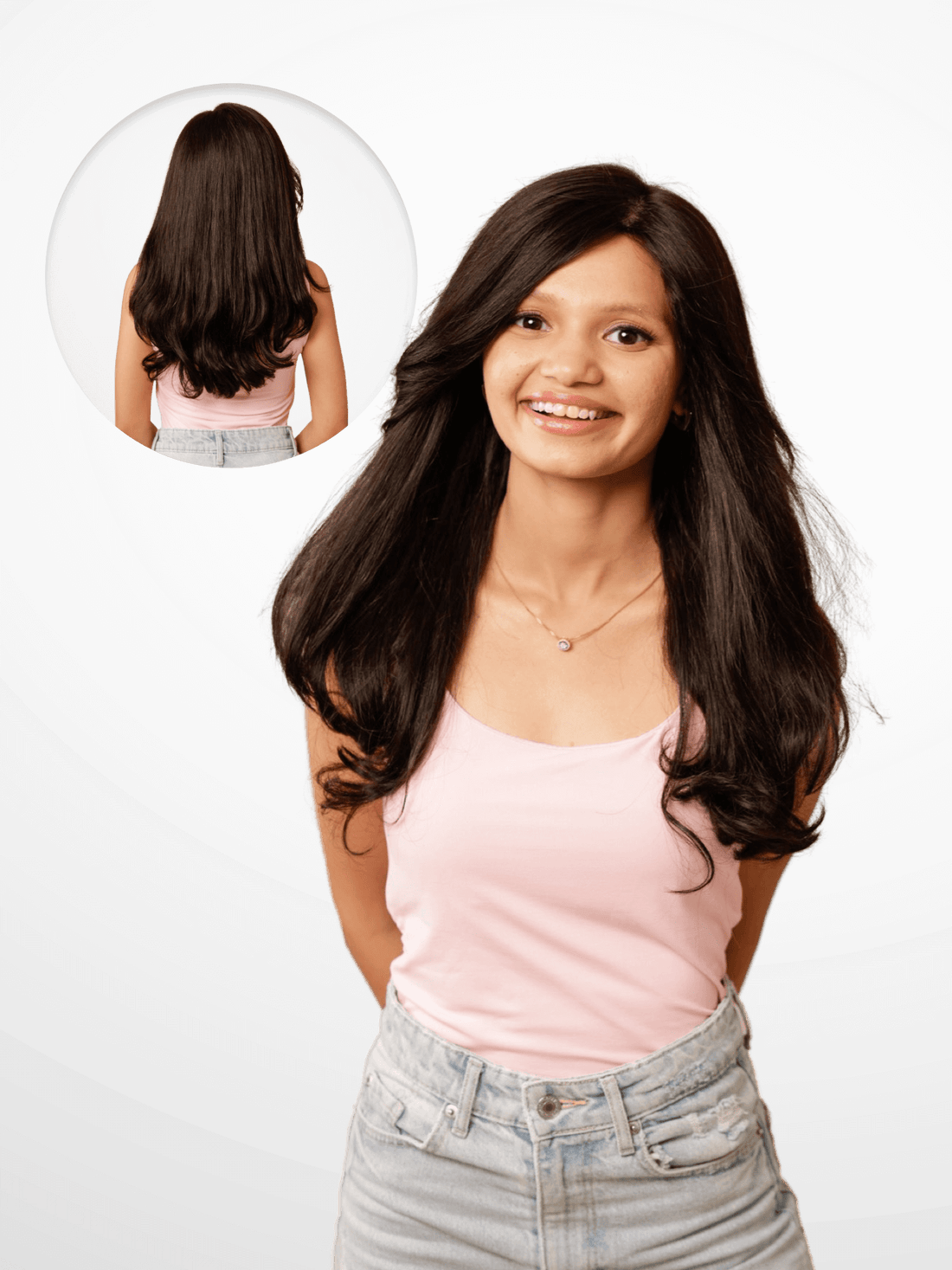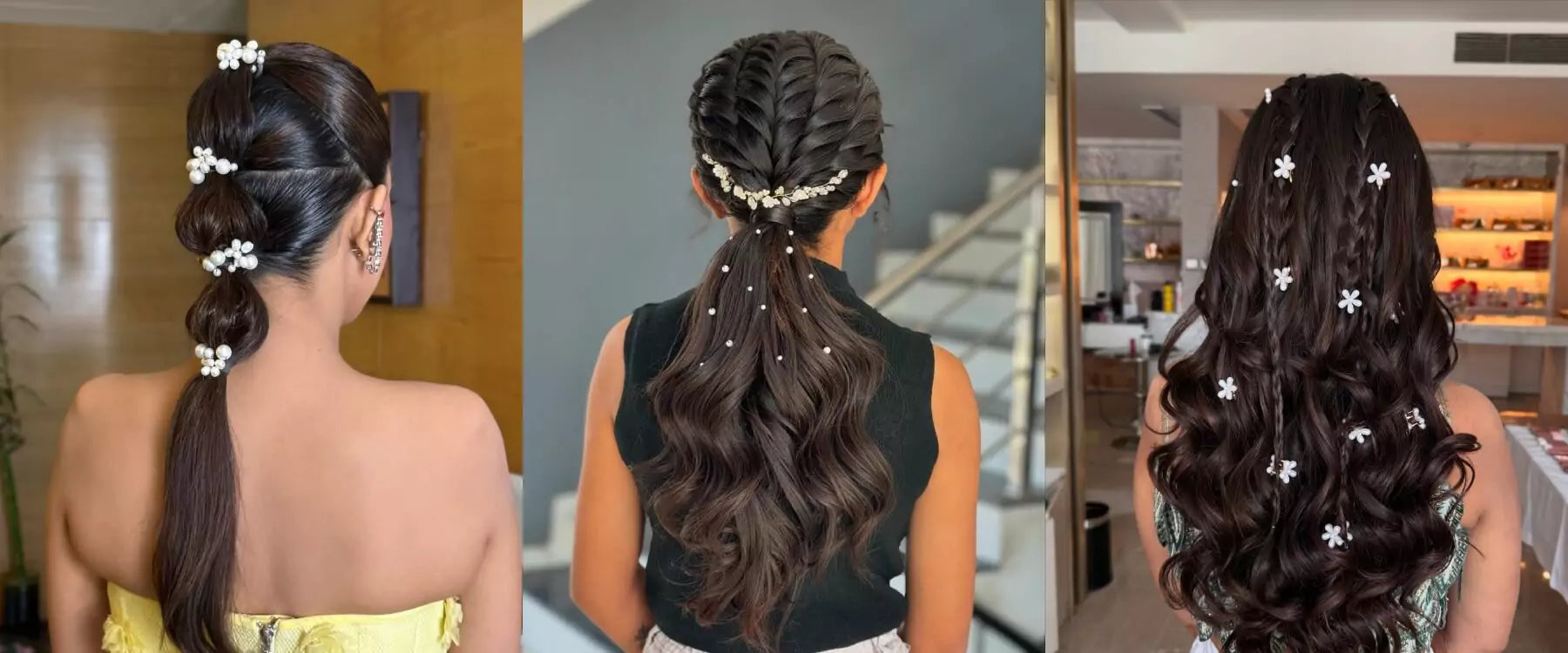Welcome, wig lovers! Have you ever wondered how to de-frizz a wig or how to fix wig frizz instantly? Whether you're a newbie to the world of wigs or a seasoned pro, we all know the struggle of dealing with frizz. Be it your natural hair or your wig, frizz is stubborn and a total look-spoiler.
But don't stress, we're here to help! Let's spill the beans on how to keep your wig frizz-free, so you can confidently embrace your locks without a care in the world. Let's dive right in!
What Causes Wig Frizz?
Understanding the root causes of wig frizz is essential in effectively combating this common issue. No matter, you're dealing with frizz in synthetic wigs or human hair wigs, it's important to know why it occurs and how to prevent it.
Some reasons for wig frizziness include:
- The quality of the wig material.
- If you do not wash, brush, and dry your wig properly
- Sometimes weather is also the reason for the frizziness of the wig, such as too much heat which can take away all the moisture from the wig and make it frizzy. Similarly, wind and rain can also lead to frizz.
- If you do not style your wig properly, it can be a reason for the wig to frizz.

Let's explore all the factors in detail that contribute to frizz in both types of wigs.
Frizz in Synthetic Wigs
Synthetic wigs are susceptible to frizz due to friction and tension. As the synthetic fiber rubs against your body or clothing, or when you brush out tangles, the individual strands of the wig can start to kink or coil.
This coiling effect leads to the fibers grabbing onto each other, resulting in clumping and loss of the wig's soft and silky texture. It becomes visually noticeable and tangible, making your wig lose its desired appearance.
To prevent frizz in synthetic wigs, it's essential to handle them with care. Use a wide-toothed comb or a wig brush designed specifically for synthetic wigs to detangle gently. Start from the ends and work your way up to avoid excessive tension and potential damage.
Additionally, minimizing friction between the wig and external surfaces can help reduce frizz. Consider wearing a satin or silk scarf underneath the wig to act as a barrier and prevent excessive rubbing against your scalp.
Frizz in Human Hair Wigs
Frizz in human hair wigs primarily occurs due to the hair drying out. Unlike your natural hair, which receives oils and moisture from your scalp, the hair in wigs lacks this natural source of hydration. Over time, if the hair in your human hair wig becomes dry and damaged, it can start to resemble a matted mess, losing its softness and manageability.
To combat frizz in human hair wigs, it's essential to focus on maintaining adequate moisture levels. Regularly hydrate your wig with high-quality wig-specific conditioning products. These products are designed to nourish and moisturize the wig hair, preventing dryness and minimizing the oocurance of frizz.
Additionally, always store your wig correctly when not in use, such as on a wig stand or in a breathable bag. It will help maintain its moisture and reduce the risk of frizz formation.
In both synthetic and human hair wigs, taking preventive measures is key to preserving the integrity of the hair fibers and ensuring a frizz-free experience. Let’s discuss in detail how you can ensure that your wig stays frizz-free and healthy in the long run.
The Pre-Wig Preparation Dance
Before we jump into the land of frizz-free wigs, let's set the stage for success. Preparing your wig and your natural hair is crucial. Here's what you need to start with:
1. Cleanse & Condition
Wash your natural hair with a mild shampoo and a nourishing conditioner. This step ensures that your hair is clean and ready for the wig-wearing adventure.
2. Dry It Up
It is best to let your hair air dry or use a blow dryer on a low heat setting. Remember, excess moisture can cause frizz, so make sure your hair is completely dry before wearing your wig.
Choose Wisely | Picking the Perfect Wig
As they say, “Well begun is half done!”. Finding the right wig is essential to minimize frizz. Consider these factors when choosing your wig:
1. Fiber Matters
When it comes to choosing the perfect wig, opting for high-quality human hair wigs vs cheap synthetic wigs is a game-changer. While synthetic wigs may be more affordable, they often fall short when it comes to replicating the look and feel of real human hair.
Let's explore why investing in a premium human hair wig can make all the difference in keeping those frizz worries at bay.
2. The Beauty of Human Hair
Human hair wigs are crafted from real, ethically sourced human hair. Which means they possess the same natural qualities and characteristics as your own hair. The smooth and silky fibers of human hair wigs mimic the texture and shine of natural hair, allowing you to achieve a seamless and frizz-free look.
With human hair wigs, you can confidently rock your locks without anyone suspecting you're wearing a wig.
3. Durability and Longevity
High-quality human hair wigs like the ones we have at 1 Hair Stop, are designed to withstand the test of time. Our hair extensions and wigs are made from premium-quality hair that has been carefully selected and processed to ensure durability and longevity. Investing in a premium-quality human hair wig means you're getting a product that is less prone to frizz and damage.
With proper care and maintenance, your human hair wig can serve as a long-term companion, maintaining its smooth and lustrous appearance.
4. Styling Freedom
One big advantage of a human hair wig is that they are versatile when it comes to styling. Just like your natural hair, these wigs can be cut, coloured, and styled as per your desired look. This styling freedom allows you to experiment with different hairstyles without the fear of frizz or damage.
Whether you want to achieve a sleek straight look, bouncy curls, or a chic up do, human hair wigs can take it all, while maintaining their frizz-free allure.
5. Wig Construction
When it comes to choosing the perfect wig, the cap construction plays a vital role in preventing frizz and ensuring a comfortable fit. So, let's delve deeper into the world of cap construction and discover the key features that will keep your wig snug and frizz-free!
6. Adjustable Straps
The first feature to look for in a wig's cap construction is adjustable straps. These straps allow you to customize the fit of your wig, ensuring it stays securely in place. By tightening or loosening the straps, you can achieve a snug fit that minimizes movement and reduces the risk of friction-induced frizz.
Also Read: How To Find The Best Wig For My Skin Tone?
7. Secure Clips
Alongside adjustable straps, secure clips are a game-changer when it comes to preventing frizz-causing wig movement. These small yet mighty clips are strategically placed within the cap of the wig, allowing you to fasten it securely to your natural hair or wig cap.
By attaching the clips to your hair or cap, you create an anchor that keeps the wig firmly in place. The result? A sleek and frizz-free look that lasts all day long.
The combination of adjustable straps and secure clips works wonders in achieving a snug fit that eliminates unnecessary movement. When your wig fits snugly against your head, there's minimal friction between the wig fibers and your natural hair or scalp. This lack of friction reduces the chances of frizz formation, leaving you with a smooth and polished appearance.
Stay Smooth and Stylish with Frizz-free Human Hair Wigs
-
Kim Wig
 Kim Wig
Kim Wig- Regular price
-
MRP ₹92,000.00 - Regular price
-
MRP ₹ - Sale price
-
MRP ₹92,000.00
Megan Wig Megan Wig
Megan Wig- Regular price
-
MRP ₹73,800.00 - Regular price
-
MRP ₹ - Sale price
-
MRP ₹73,800.00
Kylie Wig Kylie Wig
Kylie Wig- Regular price
-
MRP ₹66,600.00 - Regular price
-
MRP ₹ - Sale price
-
MRP ₹66,600.00
Jennifer Wig Jennifer Wig
Jennifer Wig- Regular price
-
MRP ₹66,600.00 - Regular price
-
MRP ₹ - Sale price
-
MRP ₹66,600.00
Taming the Frizz Monster
Now that you're ready to wear your wig, it's time to tame the frizz monster and keep it at bay. Follow these simple tips:
1. Detangle Gently
Use a wide-toothed comb or a wig brush designed specifically for wigs to detangle your hair. Start at the ends and work your way up to avoid unnecessary damage.
2. Silicone Serum Magic
Apply a small amount of silicone-based serum or wig-specific conditioning spray to your wig before styling. These products act as a barrier, preventing moisture from infiltrating the fibers and causing frizz.
3. Say No to Heat
Avoid excessive heat styling on your wigs, as it can damage the fibers and lead to frizz. If you must style, use low heat settings, and never forget to use a heat-protectant spray.
4. Overnight Care
We would suggest that you should always remove your wig before going to bed. It is not a good idea to sleep with your wig on. But if you must, invest in a satin or silk pillowcase or wrap your wig in a silk scarf before bed. These materials reduce friction and help maintain the sleekness of your wig.
Also Read: 10 Most Common Wig Problems And How To Solve Them
Tackling Frizz Emergencies
Sometimes, despite our best efforts, frizz sneaks up on us. Fear not! These emergency tips will come to your rescue:
1. Quick Fix
Keep a small bottle of water mixed with a tiny amount of leave-in conditioner handy. Spritz the mixture lightly onto your wig, and then gently comb through to tame any frizz.
2. Steamy Solution
If your wig is heat-friendly, use a handheld steamer on a low setting to relax the frizzy strands. Be cautious and maintain a safe distance to avoid damaging the wig.
3. Dry Shampoo Delight
For synthetic wigs, dry shampoo can work wonders. Sprinkle a small amount onto the frizzy areas and gently comb through. The dry shampoo absorbs excess oil and revitalizes the wig.
Long-Term Care for Frizz-Free Wigs
Maintaining a frizz-free wig requires consistent care and love. Here's what you need to do:
1. Wash with Care
Follow the manufacturer's instructions for washing your wig. Use a mild wig-specific shampoo and conditioner to keep the fibers in tip-top shape. Avoid rubbing or wringing the wig to prevent tangles and frizz. Always wash with cold water and let your wig air dry just like your natural hair.
2. Storage Magic
When not in use, store your wig on a wig stand or in a breathable and soft bag. Keep it away from direct sunlight, heat, and excessive humidity. This ensures that your wig stays fresh and free from unwanted frizz.
Conclusion
Now you've unlocked the secrets to maintaining a frizz-free wig. By following the tips and tricks of the wigs shared in this article, you can bid farewell to the frizz monster and rock your wig with confidence. Remember to prep your hair, choose the right wig, tame the frizz, handle emergencies like a pro, and provide long-term care. Now, embrace your frizz-free fabulousness!
FAQs
1. How often should I wash my wig?
The frequency of washing your wig depends on factors such as how often you wear it and your personal preference. Generally, washing your wig every 6-8 wears is a good rule of thumb.
2. Can I use regular hair products on my wig?
It's best to use products specifically formulated for wigs to maintain their quality. Regular hair products may contain ingredients that can damage the wig fibers or cause unwanted build-up.
3. Can I use heat styling tools on my wig?
Heat styling tools should be used with caution on wigs. High temperatures can damage the fibers, leading to frizz and irreversible changes. If heat styling is necessary, opt for heat-friendly wigs and use low heat settings. Also, make sure to spritz some heat protectant spray before styling. A little care goes a long way.
4. How do I store my wig to prevent frizz?
To prevent frizz, store your wig on a wig stand or in a breathable bag when not in use. Keep it away from direct sunlight, heat sources, and excessive humidity. This will help maintain the wig's smoothness and prevent frizz-inducing factors.
5. How do I stop my wig from frizzing?
To prevent frizz, ensure that you take good care of your wig. Always detangle it, store it properly and wash with care.
6. How do you refresh a frizzy wig?
To refresh a frizzy wig instantly, take a little bit of wig conditioner and apply it through the length then comb with a wide toothed comb. Avoid using too much product as it might weigh down the hair.
Book An Appointment
Latest Blogs
-

Top 15 Hairstyles for College Girls Quick & Stylish Ideas
The college phase is undoubtedly one of the best phases of life. No matter how many submissions you've got or how tired you are, you'll always want to create...
-

16 Easy Birthday Hairstyle Ideas For 2025
Your birthday is a milestone, and you have every reason to dress up, feel good, do all your favorite things the entire day. And for the party night—that beautiful outfit...
-

Best Hair Colours for Women: Find the Right Shade for You
In recent times, the hair colour segment has levelled up to a whole new height with a kaleidoscope of gorgeous shades to pick from. Today, you're not just limited to...


















